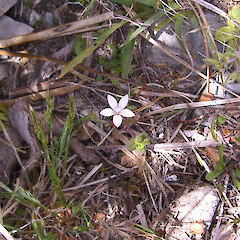Wahlenbergia rupestris
Common name
white harebell
Synonyms
Wahlenbergia colensoi N.E.Br. pro. parte., Wahlenbergia gracilis sensu Allan nom. inv.
Family
Campanulaceae
Flora category
Vascular – Native
Endemic taxon
Yes
Endemic genus
No
Endemic family
No
Structural class
Herbs - Dicotyledons other than Composites
NVS code
The National Vegetation Survey (NVS) Databank is a physical archive and electronic databank containing records of over 94,000 vegetation survey plots - including data from over 19,000 permanent plots. NVS maintains a standard set of species code abbreviations that correspond to standard scientific plant names from the Ngä Tipu o Aotearoa - New Zealand Plants database.
WAHRUP
Chromosome number
2n = 72
Current conservation status
The conservation status of all known New Zealand vascular plant taxa at the rank of species and below were reassessed in 2017 using the New Zealand Threat Classification System (NZTCS) – more information about this can be found on the NZTCS website. This report includes a statistical summary and brief notes on changes since 2012 and replaces all previous NZTCS lists for vascular plants.
Please note, threat classifications are often suggested by authors when publications fall between NZTCS assessment periods – an interim threat classification status has not been assessed by the NZTCS panel.
- Conservation status of New Zealand indigenous vascular plants, 2017 . 2018. Peter J. de Lange, Jeremy R. Rolfe, John W. Barkla, Shannel P. Courtney, Paul D. Champion, Leon R. Perrie, Sarah M. Beadel, Kerry A. Ford, Ilse Breitwieser, Ines Schönberger, Rowan Hindmarsh-Walls, Peter B. Heenan and Kate Ladley. Department of Conservation. Source: NZTCS and licensed by DOC for reuse under the Creative Commons Attribution 4.0 International licence.
2017 | Not Threatened
Previous conservation statuses
2012 | Not Threatened
2009 | Not Threatened
2004 | Not Threatened
Brief description
Radicate, perennial herb. Stems slender, erect, 100-500 mm tall, branching from the base, terete. Leaves alternate, usually linear-oblanceolate to linear*, 15-20 mm long, subentire, with scattered hairs on margins and lamina. Flowers pure white, 9-25 mm diameter, corolla almost tubeless, with long lobes and shallow, saucer-shaped tube 2 × 5 mm. Capsule glabrous, 7 × 3 to 10 × 4 mm, ellipsoid to obconic. *W. colensoi was named for forms with spathulate basal leaves rather than linear; as currently described, W. rupestris includes plants once known as W. colensoi.
Distribution
Endemic. New Zealand: North and South Islands (mainly inland sites from Whanganui, Rangitikei, Manawatu, and Wairarapa to Central Otago, excluding Canterbury Plains but including Banks Peninsula and Otago Peninsula
Habitat
Coastal to montane. Usually on rocks, cliffs, river gorges and on sparsely vegetated terraces. Only coastal in southern part of range.
Detailed description
Radicate, perennial herb. Stems slender, erect, 100-500 mm tall, branching from the base, terete. Leaves alternate, often dark green, usually linear-oblanceolate to linear*, 15-20 mm long, subentire, with scattered hairs on margins and lamina. Callus teeth 4-5 on each margin. Bracts linear, 4-20 × 2 mm. Flowers self-compatible, pure white, 9-25 mm diameter, 6-13 mm long, on slender pedicels 50-100 mm long. Corolla rotate, almost tubeless, with long lobes and shallow, saucer-shaped tube 2 × 5 mm. Corolla lobes 8 × 5 mm to 11 × 6 mm, strongly constricted below stigma lobes, white. Calyx glabrous, lobes 2.0 × 0.7 mm to 3.0 × 1.0 mm, narrow-triangular, erect. Capsule glabrous, 7 × 3 to 10 × 4 mm, ellipsoid to obconic. Bud at anther dehiscence slender, pointed. Seeds 0.5 mm long. *W. colensoi was named for forms with spathulate basal leaves rather than linear; as currently described, W. rupestris includes plants once known as W. colensoi.
Similar taxa
Recognised by the dark green to reddish-green, often narrow, alternate leaves; pure white long-petalled rotate flowers, with very shallow saucer-shaped tube and elliptic corolla lobes which are separate to base (not overlapping), resulting in a stark-like appearance when viewed from above.
Flowering
November - January
Flower colours
White
Fruiting
December to February
Propagation technique
Easily grown from fresh seed and rooted pieces. Does best in a sunny situation in well drained soil. In suitable conditions it freely naturalises and can even become weedy.
Etymology
wahlenbergia: Named in honour of Wahlenberg, a Swedish botanist and author of A Botany of Lapland.
rupestris: From the Latin rupes ‘rock, cliff’, meaning growing in rocky places
Where To Buy
Not Commercially Available
Attribution
Fact Sheet Prepared by P.J. de Lange 12 June 2007. Description adapted from Petterson (1997).
References and further reading
Petterson, J.A. 1997: Revision of the genus Wahlenbergia (Campanulaceae) in New Zealand. New Zealand Journal of Botanv 35: 9-54.
NZPCN Fact Sheet citation
Please cite as: de Lange, P.J. (Year at time of access): Wahlenbergia rupestris Fact Sheet (content continuously updated). New Zealand Plant Conservation Network. https://www.nzpcn.org.nz/flora/species/wahlenbergia-rupestris/ (Date website was queried)




